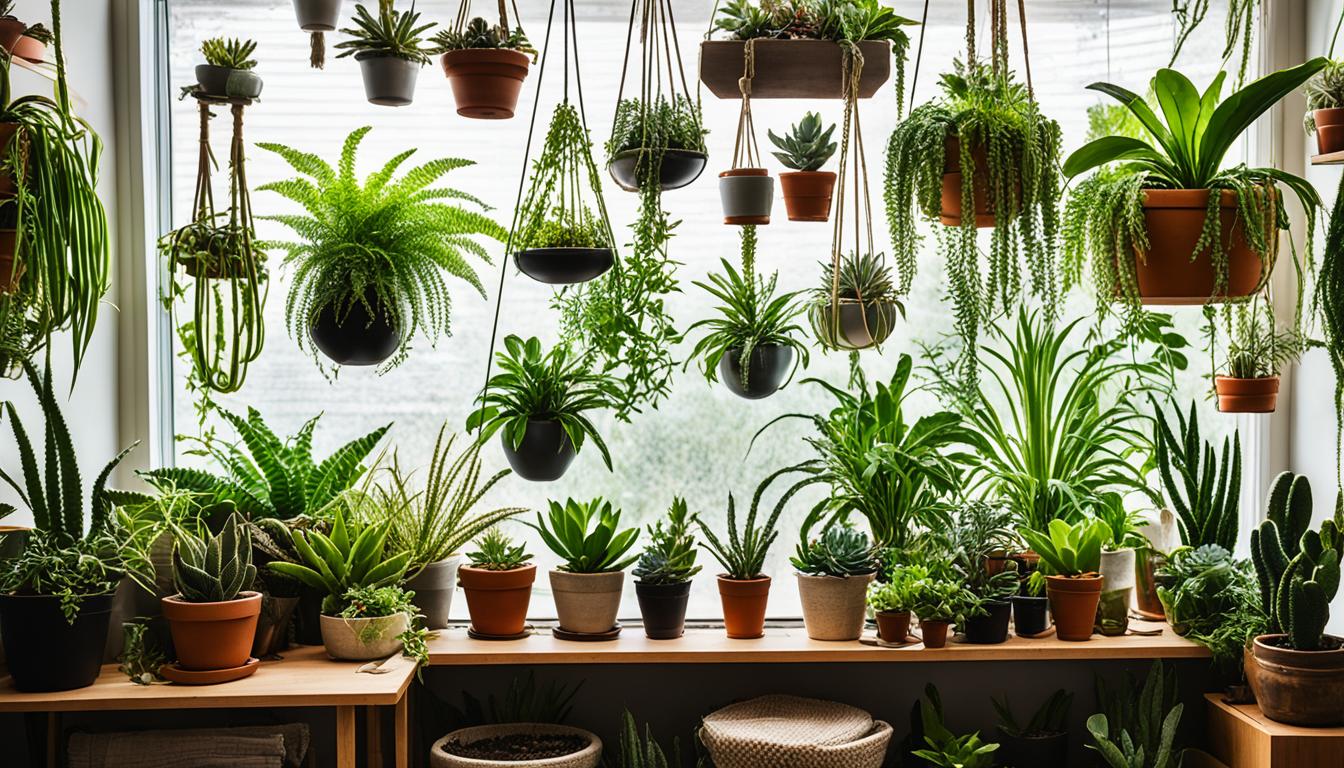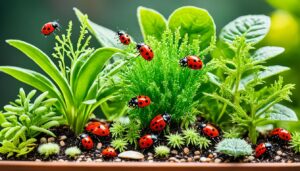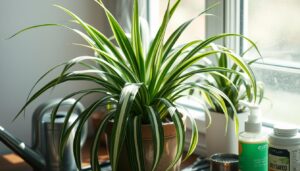Are you having trouble keeping your indoor plants healthy? The key to a lush indoor garden is learning how to water correctly. We’ll share the best practices for watering indoor plants and the mistakes to avoid. Follow these expert tips to keep your houseplants happy and healthy all year round.
Watering indoor plants might seem easy, but it can lead to problems. Issues like overwatering or underwatering can harm your plants. It’s important for both experts and beginners to know the right way to water. Let’s explore the secrets of watering schedules for indoor plants and learn about the water requirements for houseplants to improve your gardening skills.
Introduction to Proper Indoor Plant Watering
Proper indoor plant watering is key to keeping your houseplants healthy. It’s important to know the right way to water your plants. Many gardeners make common watering mistakes that harm their plants.
Importance of Proper Watering Techniques
Watering your indoor plants right is vital for their health and growth. It helps them get the moisture they need for photosynthesis and nutrient uptake. If you don’t water them correctly, they might wilt, grow slowly, or even die.
Common Mistakes in Watering Indoor Plants
- Overwatering: Too much water can drown the roots and cause root rot and diseases.
- Underwatering: Not enough water can make plants wilt, drop leaves, and grow poorly.
- Inconsistent watering: Plants prefer regular watering and can suffer from stress if it’s not consistent.
- Improper watering techniques: Watering the leaves instead of the soil can harm your plants.
Knowing the importance of proper watering and avoiding these mistakes helps your plants thrive. This makes your home look better and brings you joy.
“The key to successful indoor gardening lies in mastering the art of proper plant watering.”
Factors Influencing Watering Needs
When watering indoor plants, knowing what affects their water needs is key. Different plants, pot sizes, soil types, and environmental conditions all play a big role. These factors help determine the best watering schedule.
Plant Type and Water Requirements
Each indoor plant has its own water needs based on where it comes from and how it grows. For example, succulents and cacti need less water than leafy plants. Knowing what your plant needs is the first step to watering it right.
Pot Size and Soil Mix
The size of your plant’s pot and the soil it’s in also matter. Smaller pots dry out faster, so you might need to water more often. Also, soil that drains well loses moisture quicker than heavy soil. Keeping these things in mind helps you water your plant just right.
Environmental Conditions: Light, Temperature, and Humidity
The place where your indoor plants live affects how much water they need. Things like light, temperature, and humidity levels can change how fast plants lose moisture. Adjusting your watering based on these conditions is key to keeping your plants healthy.
| Factor | Impact on Watering Needs |
|---|---|
| Plant Type | Succulents and cacti require less frequent watering than leafy, fast-growing plants. |
| Pot Size | Smaller pots dry out more quickly, necessitating more frequent watering. |
| Soil Mix | Well-draining soil mixes tend to lose moisture faster than dense, heavy soils. |
| Light Exposure | Plants in bright, direct light may require more frequent watering than those in low light conditions. |
| Temperature | Higher temperatures can increase the rate of evaporation, leading to more frequent watering needs. |
| Humidity | Low humidity environments can cause plants to lose moisture more quickly, requiring more water. |
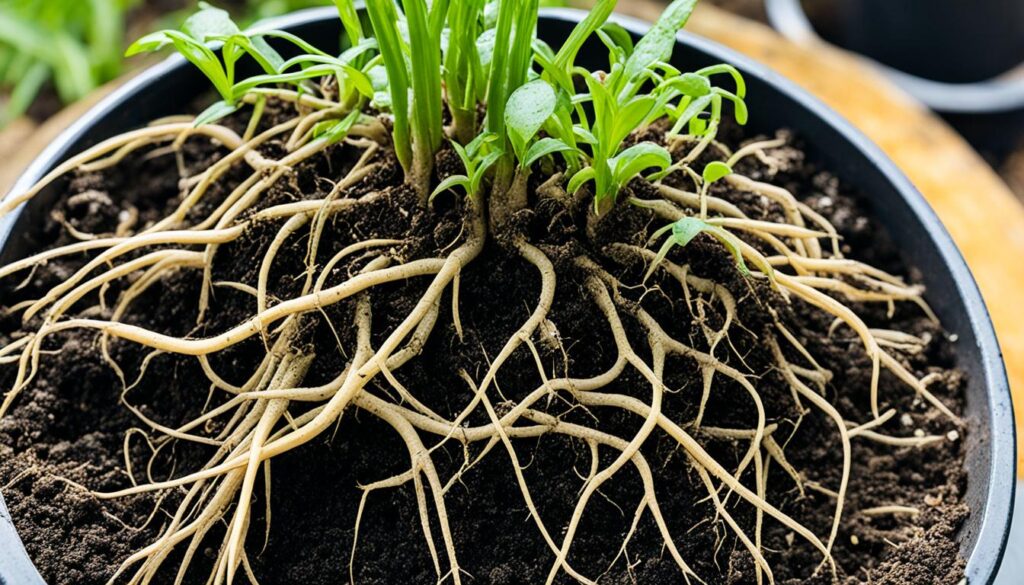
Understanding these factors helps you create a watering plan that keeps your houseplants happy and healthy.
watering indoor plants
Proper watering is key to keeping indoor plants healthy. To make sure your houseplants get enough water, learn how to check soil moisture and use the best watering methods.
How to Check Soil Moisture
To know when to water your indoor plants, check the soil moisture. Here are ways to do it:
- Stick your finger into the soil up to the second knuckle. If it feels dry, it’s time to water.
- Lift the plant’s pot – if it feels light, the soil is dry and needs water.
- Use a moisture meter for precise soil moisture levels, making it easier to know when to water.
Optimal Watering Methods and Techniques
After figuring out your plants need water, use the right watering techniques. Here are some best practices:
- Top-watering: Slowly pour water onto the soil, letting it soak in well. This method prevents overwatering and ensures even moisture.
- Bottom-watering: Put the plant’s pot in a tray of water for the soil to absorb moisture from the bottom. It’s great for plants that don’t like wet leaves.
- Drainage: Make sure your plant’s pot has drainage holes to let out excess water. This prevents waterlogging and root rot.
Mastering soil moisture checking and the best watering methods keeps your indoor plants healthy and hydrated all year.
Signs of Over and Underwatering
Knowing how to spot when your indoor plants get too much or too little water is key. It helps keep them healthy and full of life. By noticing the signs of overwatering and underwatering, you can fix your watering schedule. This ensures your plants do well.
Identifying Overwatering Symptoms
Overwatered plants show these signs:
- Yellowing or wilting leaves, even if the soil is wet
- Mushy, soft, or discolored stems
- Presence of fungal growth or root rot
- Foul, stagnant odor coming from the soil
Recognizing Underwatering Indicators
Plants that don’t get enough water will show these signs of underwatering:
- Wilting, drooping, or curling leaves
- Discoloration, like leaves turning brown or yellow
- Dry, brittle, or cracked soil
- Slow growth or stunted development
By watching for these signs of overwatering and signs of underwatering, you can spot and fix any watering problems in houseplants. This keeps your indoor plants healthy with the right moisture.
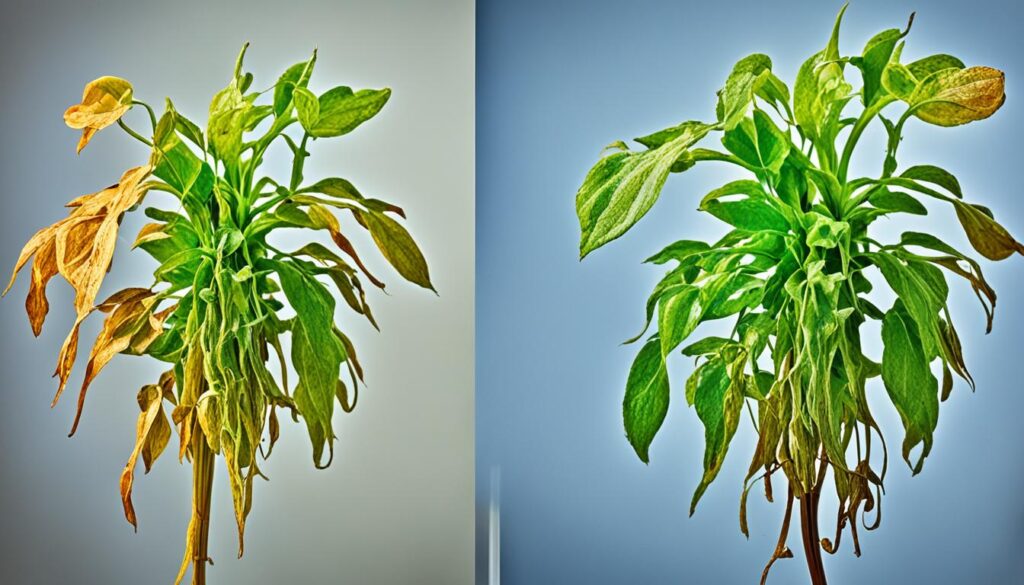
“Proper watering is the foundation of plant health. By understanding the visual cues, you can become a master of identifying and resolving any watering issues in your indoor garden.”
Conclusion
To keep your indoor plants healthy, follow the best watering practices. Each plant has its own needs, so check the soil often. Adjust how much you water based on the environment.
Understanding how to water plants right is key. Know what affects their watering needs. Use the best methods to keep moisture levels perfect. This way, you avoid mistakes that harm your plants.
Keep an eye on your plants and adjust as needed. Enjoy watching them grow and flourish. With the right watering, your indoor plants will stay green and beautiful. Your green oasis will show off your gardening skills.
FAQ
What are the key factors that influence the watering needs of indoor plants?
Many things affect how much water indoor plants need. These include the type of plant, the size of the pot, the soil type, and the environment. Things like light, temperature, and humidity matter too.
How can I properly check the soil moisture to determine when my plants need water?
To see if the soil is dry, you can stick your finger into it. Look for the color and feel of the soil. Or, you can use a moisture meter. These methods help you know when to water your plants.
What are the optimal watering methods and techniques for indoor plants?
For indoor plants, top-watering and bottom-watering are good methods. Top-watering lets water go through the soil. Bottom-watering pulls moisture up from the pot’s base. It’s important to make sure the soil drains well.
How can I identify the signs of overwatering and underwatering in my indoor plants?
Overwatering can make leaves turn yellow, stems get mushy, and roots rot. Underwatering makes leaves wilt, droop, and change color. Knowing these signs helps you adjust your watering.
What type of water is best for indoor plants?
For indoor plants, use filtered or distilled water. This type of water has fewer minerals and impurities. These can harm plant health if they build up in the soil.


